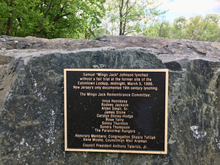Mingo Jack – Wikipedia
From Wikipedia, the free encyclopedia
Black man lynched by a mob over false rape accusation
Samuel “Mingo Jack” Johnson (1820 – March 5, 1886) was an African-American man falsely accused of rape. He was brutally beaten and hanged by a mob of white men in Eatontown, New Jersey.
Biography[edit]
Johnson was born in Colts Neck in 1820 and was raised as a slave by the Laird family. Because he was short, the family used him as a jockey, and he rode a colt named Chief Mingo to victory, earning him the nickname Mingo Jack.[1] In 1840, New Jersey abolished slavery, and Johnson worked odd jobs in the Eatontown and Middletown areas, living in Eatontown near what is now Route 35 and Poplar Road.
Lynching[edit]
In March 1886, a white woman, Angelina Herbert, was raped and beaten. She could not identify her attacker, but reported that the attacker had asked her, “Do you know Mingo Jack”? Johnson was arrested. That night, a mob of up to 75 people chiseled holes in the wall of the jail in which Mingo Jack was held and fired guns, attempting to kill Johnson. When that effort failed, they stormed the jail, beat Johnson and hanged him.
A sham trial for some members of the lynch mob was held, featuring drunken witnesses and a jury that included the prominent townsman Thomas White, resulting in acquittals for all the defendants. Information from the trial, including testimony from Mrs. Herbert, revealed that Johnson couldn’t have been the rapist.
No one was convicted for the murder of Mingo Jack, who left behind a wife and five children.[2] Another black man, George Kearney, later confessed to the rape, although that confession may have been coerced.[3]
In 2012, Mayor Gerald Tarantolo issued a public apology for the failure of security at the jail, calling the lynching “a low point in the history of Eatontown”. A small memorial was placed in Wampum Park.[4][5]

See also[edit]
References[edit]
- ^ Howley, Dan. “Anniversary of ‘Mingo Jack’ lynching to be marked; Mingo Jack Remembrance Group to hold March 5 memorial gathering”, Atlanticville News, March 3, 2011. Accessed December 26, 2017. “Born in Colts Neck in 1820, Johnson was abandoned by his parents and raised by a white family, the Lairds. The Lairds used Johnson as a slave, and because of his size — he was short and stocky — as a jockey.”
- ^ Stone, James (2010). The Murder of Mingo Jack: New Jersey’s Only Nineteenth Century Lynching. iUniverse. ISBN 9781450213202.
- ^ “George Kearney”. New York Herald. 19 July 1998.
- ^ Spahr, Rob (24 September 2012). “Lynching of former slave memorialized as ‘low point’ in Eatontown history”. Retrieved 24 December 2017.
- ^ English, Bob (27 September 2012). “Memorial Unveiled Near The Eatontown Location Of The Lynching Of Samuel “Mingo Jack” Johnson In 1888″. Retrieved 24 December 2017.
Recent Comments